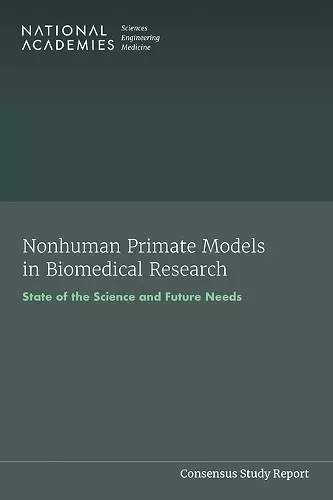Nonhuman Primate Models in Biomedical Research
State of the Science and Future Needs
Division on Earth and Life Studies author Board on Health Sciences Policy author Institute for Laboratory Animal Research author National Academies of Sciences, Engineering, and Medicine author Health and Medicine Division author Committee on the State of the Science and Future Needs for Nonhuman Primate Model Systems author Olivia C Yost editor Autumn Downey editor
Format:Paperback
Publisher:National Academies Press
Published:23rd Jul '23
Currently unavailable, and unfortunately no date known when it will be back

Nonhuman primates represent a small fraction of animals used in biomedical research, but they remain important research models due to their similarities to humans with respect to genetic makeup, anatomy, physiology, and behavior. Limitations in the availability of nonhuman primates have been exacerbated by the COVID-19 pandemic and recent restrictions on their exportation and transportation, impacting National Institutes of Health (NIH)-funded research necessary for both public health and national security. Additionally, there is continued interest in understanding whether and how nonanimal models can be used to answer scientific questions for which nonhuman primates are currently used.
At the direction of the U.S. Congress, NIH asked the National Academies of Sciences, Engineering, and Medicine to convene an expert committee to conduct a landscape analysis of current and future use of nonhuman primates in NIH-supported biomedical research, as well as opportunities for new approach methodologies to complement or reduce reliance on nonhuman primate models. This report provides the committee findings and conclusions.
Table of Contents- Front Matter
- Summary
- 1 Introduction
- 2 Contribution of Nonhuman Primate Models to Advances in Human Health
- 3 Current Landscape of Use and Availability of Nonhuman Primates for NIH-Supported Biomedical Research
- 4 The Landscape of New Approach Methodologies
- 5 Future Needs and Opportunities for Nonhuman Primate Models in Biomedical Research
- Appendix A: Study Approach and Methods
- Appendix B: Data on Nonhuman Primate Use in NIH-Supported Biomedical Research
- Appendix C: Biographical Sketches of Committee Members and Staff
- Appendix D: Disclosure of Unavoidable Conflicts of Interest <
ISBN: 9780309699365
Dimensions: unknown
Weight: unknown
268 pages